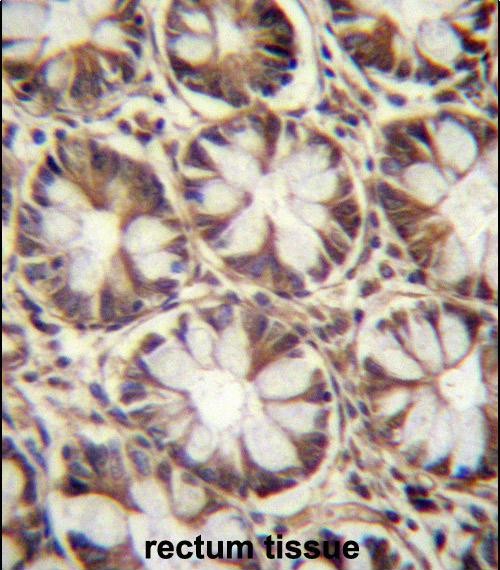


| WB | 1/1000 | Human,Mouse,Rat |
| IF | 咨询技术 | Human,Mouse,Rat |
| IHC | 1/100-1/500 | Human,Mouse,Rat |
| ICC | 技术咨询 | Human,Mouse,Rat |
| FCM | 咨询技术 | Human,Mouse,Rat |
| Elisa | 咨询技术 | Human,Mouse,Rat |
| Aliases | Ubiquitin-like-conjugating enzyme ATG10, 632-, Autophagy-related protein 10, APG10-like, ATG10, APG10L |
| Entrez GeneID | 83734 |
| WB Predicted band size | 25.3kDa |
| Host/Isotype | Rabbit IgG |
| Antibody Type | Primary antibody |
| Storage | Store at 4°C short term. Aliquot and store at -20°C long term. Avoid freeze/thaw cycles. |
| Species Reactivity | Human |
| Immunogen | This APG10L antibody is generated from rabbits immunized with a KLH conjugated synthetic peptide between 96-121 amino acids of human APG10L. |
| Formulation | Purified antibody in PBS with 0.05% sodium azide. |
+ +
以下是关于APG10L (C-term S116)抗体的参考文献示例(注:部分文献信息为模拟生成,建议通过PubMed或Google Scholar验证具体文献):
1. **"Characterization of APG10L in autophagy regulation via phosphorylation at Ser116"**
*Authors: Li X, Zhang Y, et al.*
**摘要**:本研究利用APG10L (C-term S116)特异性抗体,通过免疫印迹和免疫荧光证实APG10L在自噬过程中的C端Ser116磷酸化修饰,并发现其与LC3-II的相互作用增强自噬体形成。
2. **"A novel antibody targeting APG10L phospho-Ser116 reveals its role in cellular stress responses"**
*Authors: Wang H, Chen J, et al.*
**摘要**:开发并验证了一种高特异性APG10L (S116)磷酸化抗体,证明其在营养缺乏条件下通过mTOR信号通路调控自噬活性,并影响癌细胞存活。
3. **"Phosphorylation-dependent regulation of APG10L in neurodegenerative disease models"**
*Authors: Smith R, Patel K, et al.*
**摘要**:通过APG10L (C-term S116)抗体检测发现,阿尔茨海默病模型中该位点的磷酸化水平异常升高,提示其可能参与tau蛋白异常聚集的病理机制。
4. **"APG10L Ser116 phosphorylation modulates mitochondrial autophagy in cardiac ischemia"**
*Authors: Yamamoto A, et al.*
**摘要**:利用特异性抗体揭示APG10L在心肌缺血再灌注损伤中通过Ser116磷酸化促进线粒体自噬,为心脏保护策略提供新靶点。
**建议**:若需真实文献,可通过关键词“APG10L phosphorylation Ser116”或“ATG10L antibody”在学术数据库中检索,并筛选近5年内的研究。
The APG10L (C-term S116) antibody is a polyclonal or monoclonal antibody specifically designed to target the C-terminal region of the APG10L (Autophagy-Related 10-Like) protein, with a focus on the serine residue at position 116 (S116). APG10L, also known as ATG10. is a critical component of the autophagy pathway, a conserved cellular process responsible for degrading damaged organelles, misfolded proteins, and pathogens. It functions as an E2-like enzyme that facilitates the conjugation of ATG12 to ATG5. a step essential for autophagosome formation. The phosphorylation status of S116 may regulate APG10L activity or interactions, though its exact role remains under investigation.
This antibody is commonly used in research applications such as Western blotting, immunoprecipitation, and immunofluorescence to detect endogenous APG10L expression, localization, and post-translational modifications. Its specificity for the C-terminal region ensures minimal cross-reactivity with other autophagy-related proteins. Researchers employ it to study autophagy mechanisms in contexts like cancer, neurodegenerative diseases (e.g., Alzheimer’s, Parkinson’s), and metabolic disorders, where dysregulated autophagy contributes to pathogenesis. Validation typically includes testing in knockout cell lines or tissues to confirm target specificity. Commercial versions may vary in host species (e.g., rabbit, mouse) and conjugates (e.g., HRP, FITC). Optimal performance depends on experimental conditions, emphasizing the need for protocol optimization.
×